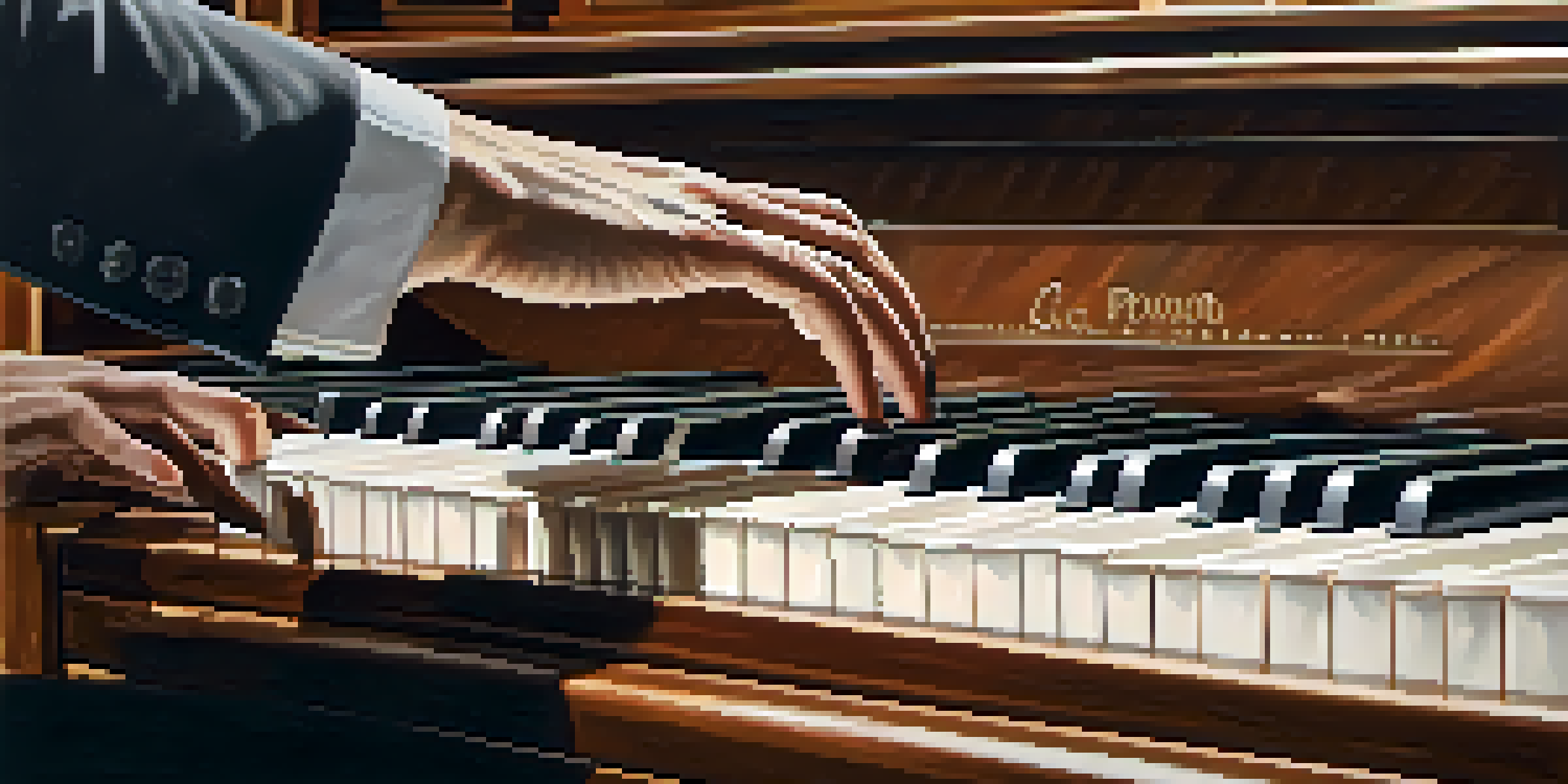Effective Finger Strengthening Exercises for Pianists

Understanding the Importance of Finger Strength for Pianists
Finger strength is crucial for pianists, as it directly impacts playing technique and overall performance. Strong fingers allow for better control over dynamics, articulation, and speed, making it easier to express emotions through music. Without adequate finger strength, even the most skilled pianists may struggle with complex pieces.
The piano is a monster that screams when you touch its keys.
Moreover, building finger strength can help prevent injuries that often arise from repetitive motions, such as tendonitis or strain. By incorporating strength exercises into your routine, you enhance your endurance, allowing for longer practice sessions without discomfort. This foundational strength supports not just performance, but also the joy of playing.
In short, prioritizing finger strength is essential for all pianists, whether you're just starting out or are a seasoned performer. Understanding its importance sets the stage for incorporating effective exercises that will enhance your playing experience.
Warm-Up: Preparing Your Fingers for Exercise
Before diving into strengthening exercises, it's vital to warm up your fingers. Just like athletes stretch before a big game, pianists should prepare their hands to prevent injury and improve performance. Simple warm-up exercises can increase blood flow and flexibility, paving the way for more intensive work.

One effective warm-up involves gentle finger stretches, where you extend and flex each finger individually. Another option is to play simple scales slowly, focusing on even pressure and smooth transitions. These activities not only prepare your fingers but also help you develop a greater awareness of your hand movements.
Finger Strength Enhances Performance
Building finger strength is essential for pianists as it improves control, dynamics, and the ability to express emotions through music.
Remember, taking time to warm up is not just a preliminary step; it’s an essential part of your practice routine. A well-prepared hand can make a significant difference in your playing, ensuring you're ready to tackle the exercises ahead.
Exercise 1: Finger Lifts for Strengthening Muscles
Finger lifts are a straightforward yet effective exercise for building finger strength. To perform this exercise, place your hand flat on a table and lift each finger one at a time, holding it in the air for a few seconds before lowering it. This simple motion engages the muscles in your fingers and helps develop independence, which is crucial for playing the piano.
Practice does not make perfect. Only perfect practice makes perfect.
As you become more comfortable with finger lifts, you can increase the number of repetitions or add weights, such as small objects, to your fingers. This will further challenge your muscles and promote growth. To keep things engaging, try incorporating different rhythms while lifting your fingers.
In addition to strengthening your fingers, this exercise can help improve your dexterity, making it easier to navigate complex pieces. With consistent practice, you'll notice a marked improvement in your finger control and overall playing ability.
Exercise 2: The Five-Finger Exercise for Coordination
The five-finger exercise is a classic technique that pianists have used for generations. It involves playing five notes in sequence, typically using the fingers of one hand, which helps build coordination and finger strength simultaneously. Start with a simple pattern, such as C-D-E-F-G, and repeat it in various octaves.
As you get comfortable with the basic pattern, try playing it with different dynamics—softly, loudly, or with accents. This not only challenges your strength but also develops your musical expression. The ability to play with varying dynamics is essential for conveying emotion in music.
Warm-Up and Cool Down are Vital
Properly warming up and cooling down your fingers can prevent injuries and promote flexibility, ensuring longevity in your playing.
Additionally, incorporating this exercise into your daily routine will promote muscle memory, making it easier to transition between notes during pieces. The five-finger exercise is a fundamental building block that can significantly enhance your finger agility.
Exercise 3: Finger Spreads for Flexibility and Reach
Finger spreads are an excellent way to improve both flexibility and reach, essential qualities for any pianist. To practice this exercise, stretch your fingers apart as wide as possible while keeping them flat on a surface. Hold this position for several seconds before relaxing them back together.
You can also incorporate finger spreads into your playing by practicing scales or arpeggios, making sure to stretch your fingers as you move from note to note. This will not only enhance your reach but also promote evenness in your playing.
Remember, flexibility is just as important as strength when it comes to mastering the piano. By regularly practicing finger spreads, you'll develop a greater range of motion, allowing you to tackle challenging pieces with ease.
Exercise 4: The Piano Finger Push-Up for Endurance
The piano finger push-up is a fun and challenging exercise that builds finger endurance. To perform this exercise, place your fingers on the keys and press down as if you're playing, but without actually striking the keys. Hold the pressure for a few seconds, then release and repeat.
This exercise mimics the motion of playing without the impact of hitting the keys, making it a safe way to build strength over time. As you get stronger, try to increase the duration of each hold or add in variations, such as pressing down with different fingers in sequence.
Consistency Yields Significant Gains
Incorporating finger strengthening exercises into your daily routine, even for just a short time, can lead to noticeable improvements over time.
Incorporating piano finger push-ups into your routine will enhance your stamina, enabling you to play longer without fatigue. With consistent practice, you'll find that your fingers become more resilient, allowing you to tackle even the most demanding pieces effortlessly.
Cool Down: Stretching to Maintain Flexibility
Just as warming up is crucial, cooling down after your exercises is equally important. Stretching your fingers and hands after practice can help prevent tension and promote relaxation. Gentle stretches can keep your muscles flexible and ready for your next session.
A great cool-down stretch involves extending your fingers wide and holding that position for 10-15 seconds. You can also gently massage your fingers and hands to release any built-up tension. This practice encourages blood circulation, which can aid recovery after a rigorous practice session.

Remember, a proper cool-down routine not only feels good but also contributes to your long-term finger health. Taking care of your hands and fingers ensures that you can continue enjoying the piano for years to come.
Consistency is Key: Making Exercises Part of Your Routine
To see improvement in finger strength, consistency is key. Incorporating these exercises into your daily practice routine, even for just 10-15 minutes, can lead to significant gains over time. Building a habit is essential; just like learning a new piece, regular practice will yield the best results.
Consider setting specific times for your finger exercises, treating them as an integral part of your piano practice. You might even want to track your progress to stay motivated, noting how your strength and dexterity improve over time. Celebrate small victories, as they contribute to your overall growth.
Ultimately, the effort you put into strengthening your fingers will pay off in your playing. By making these exercises a regular part of your routine, you’ll enhance your skills and deepen your connection to the music you love.